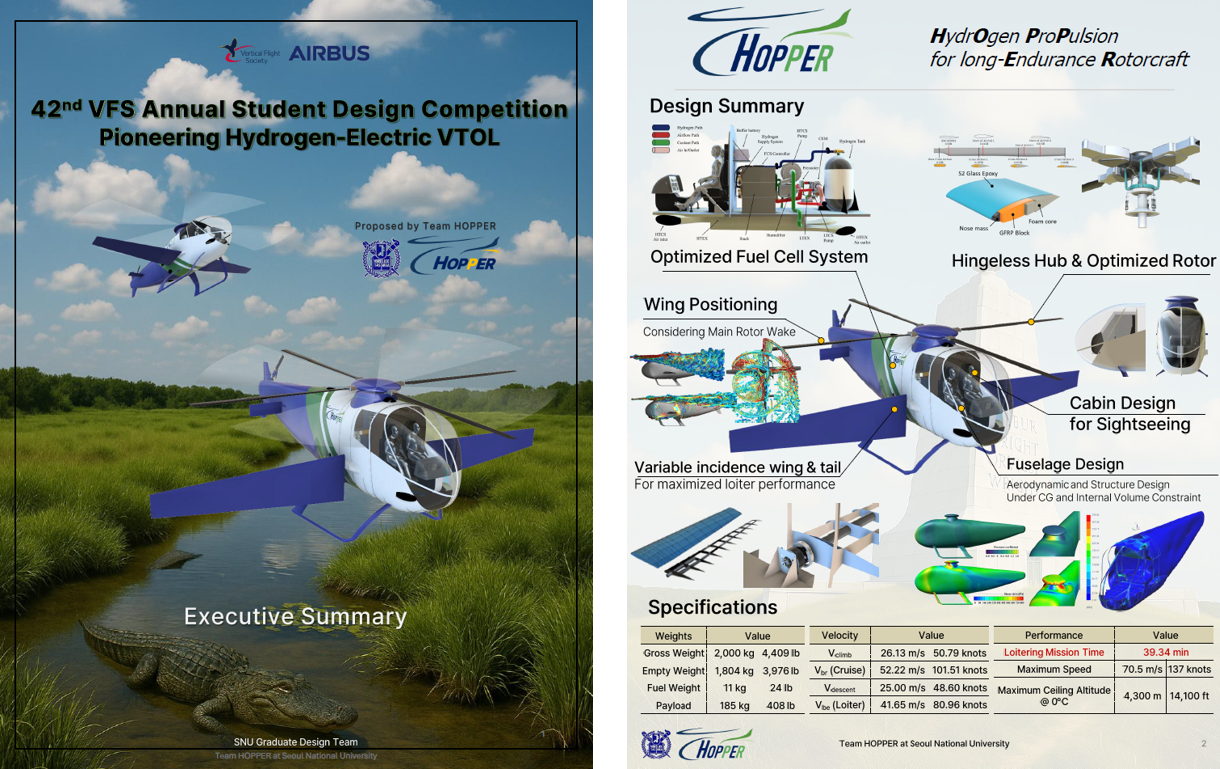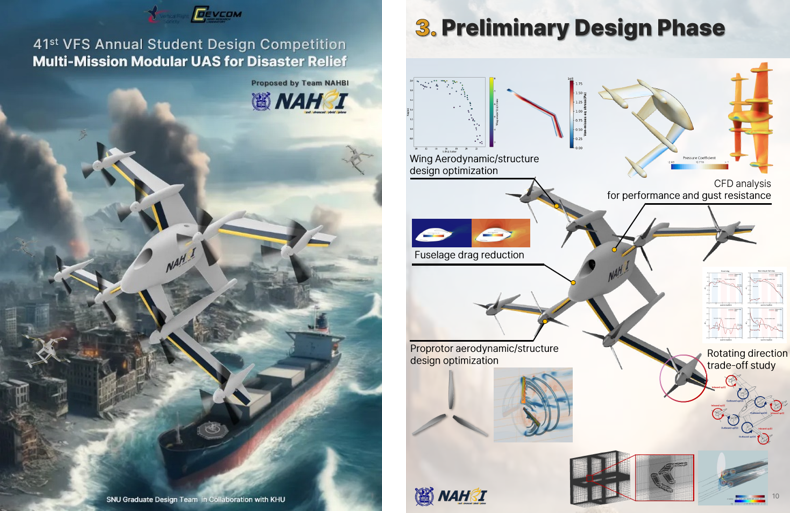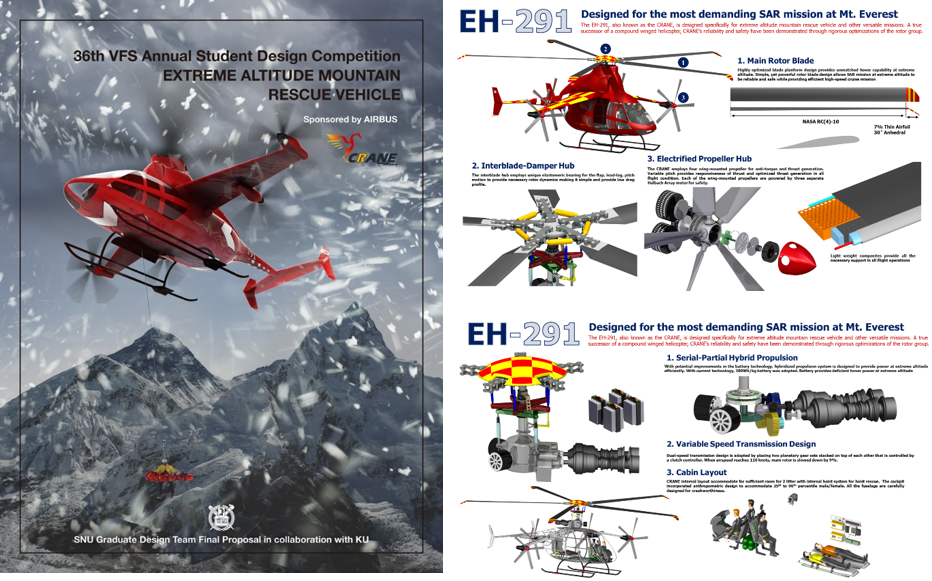VFS Student Competitions
42nd VFS Student Design Competition (2025)
-Date: May, 2025
-Organizer: Vertical Flight Society (VFS) sponsored by AIRBUS
-Participants:
Jeonghwan Kim (Team Lead), Junhwi Park, Hyunsoo Kim, Younghyo Kim, Taemin Jeong, Jinwhuy Lee, Seongjoong Park, Jaehyun Cho, In Young Lee, Seonghyun Jeong
-Award: On-process (Graduate Category)
-Summary:
Our team participated in the 42nd Annual VFS Student Design Competition, which focused on the design of an innovative hydrogen compound rotorcraft for crocodile sightseeing. We designed HOPPER, short for "Hydrogen propulsion for long-Endurance rotorcraft," as an efficient hydrogen-powered vertical take-off and landing(VTOL) aircraft for tour.
The design of HOPPER was carried out using a multi-level, large-scale optimization framework to meet demanding mission requirements, while utilizing a fuel cell system based on gaseous hydrogen. Comprehensive exploration during initial sizing, optimization involving aerodynamics, structural analysis, and hydrogen propulsion system sizing, as well as high-fidelity design using CFD and FEA, enabled the successful accomplishment of a highly challenging mission.
HOPPER, developed through these technologies, not only demonstrates the successful execution of the mission, but also validates the engineering feasibility of a single-rotor aircraft powered solely by hydrogen fuel cells.
- Design Theme:
" Pioneering Hydrogen-Electric VTOL”

41st VFS Student Design Competition (2024)
-Date: May, 2024
-Organizer: Vertical Flight Society (VFS) sponsored by DEVCOM
-Participants:
S Jeonghwan Kim (Team Lead), Junhwi Park, Hyunsoo Kim, Younghyo Kim, Taemin Jeong, Jinwhuy Lee, Seongjoong Park, Jeonguk Choi, Jaehyun Cho, Berenice Chatelain, Seonghyun Jeong
-Award: Best New Entry (Graduate Category)
-Summary:
Our team participated in the 41st Annual VFS Student Design Competition, which focused on the design of an innovative tailsitter UAS for disaster relief. We designed NAHBI, short for "Next Advanced Hybrid Biplane," as a multi-mission modular platform capable of addressing various emergency scenarios. NAHBI is engineered with VTOL capabilities that enable efficient operations in confined spaces and rapid deployment in challenging environments.
Our design features a modular architecture that allows quick reconfiguration for diverse missions such as surveillance, search and communication relay, and cargo delivery during disaster response. Additionally, the integration of a turboelectric propulsion system ensures high energy efficiency, making NAHBI a reliable asset for extended operations.
- Design Theme:
"Multi-Mission Modular Tailsitter UAS for Disaster Relief”

36th VFS Student Design Competition (2019)
-Date: May, 2019
-Organizer: Vertical Flight Society (VFS) sponsored by AIRBUS
-Participants:
Se Kwon Kang (Team Lead), Hyeongseok Kim, Donguk Lee, Daejin Lim, Dawoon Lee, Taekeun Yoon, Yoonpyo Hong, Soomin Jeong, Ohsoo Park(KHU), Seong Han Lee(KU), SangHo Kang(KU)
-Award: 2nd Place & Best New Entry (Graduate Category)
-Summary:
Our team participated in the 36th Annual VFS Student Design Competition, which focused on the design of an extreme altitude mountain rescue vehicle. In response to the RFP, we developed CRANE—a compound winged helicopter tailored for high-altitude search and rescue (SAR) operations. CRANE was engineered to perform demanding missions in harsh environments, including the ability to hover at altitudes up to 29,100 feet, as encountered on Mount Everest. Its innovative winged configuration offloads rotor thrust, thereby enhancing efficiency and safety in thin air conditions, while supporting rapid emergency deployment and payload transport.
Our design process incorporated rigorous physics-based sizing, aerodynamic optimization, and advanced structural analysis to ensure that CRANE meets the stringent mission requirements. The vehicle is capable of executing multiple flight segments—from taxiing and takeoff to extended cruise climbs and precision hovering—making it a versatile platform for mountain rescue operations. Through collaborative innovation and detailed engineering, our team successfully demonstrated a rotorcraft design that not only meets but exceeds the challenges presented by extreme altitude SAR missions.
- Design Theme:
"A compact, efficient, and robust compound winged helicopter optimized for extreme altitude mountain rescue operations"

Reference
https://vtol.org/awards-and-contests/student-design-competition